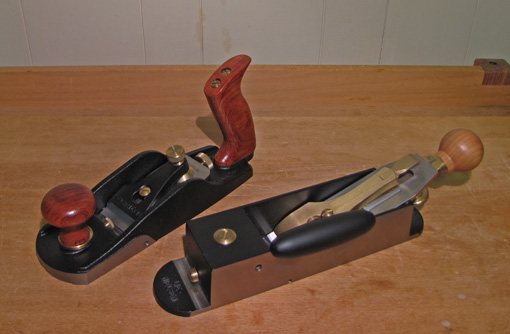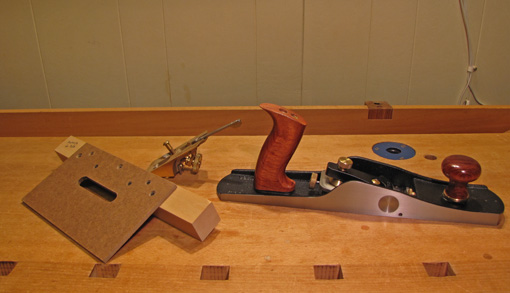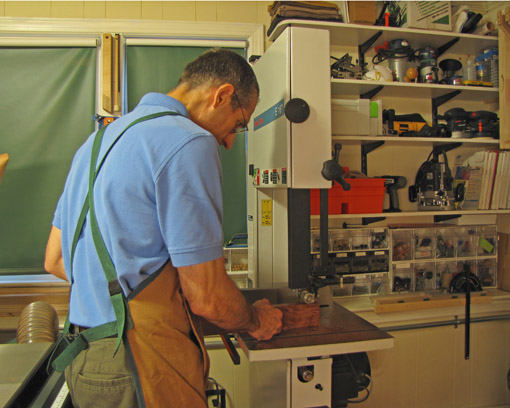Bevel-up, low-angle smoothing, jack, and jointer planes made by Lie-Nielsen and Lee Valley have 12 degree beds for their blades. This style of plane is simple to set up and especially versatile. The use of a thick blade, 3/16″ or more, supported very close to its cutting edge, and an easily adjustable throat opening contribute to effective planing.
One of the most important advantages of these planes is their ability to employ blades sharpened at different angles to manage a range of woods. With the 12 degree bed, a blade sharpened with a 33 or 38 degree bevel (secondary bevel) results in a 45 or 50 degree cutting angle, respectively. Either would be a reasonable choice for general work.
To get a 60 degree cutting angle for difficult figured woods, the blade needs a 48 degree bevel. The result is effective but this makes the blade more difficult to sharpen to a keen edge. Furthermore, this is a large wedge to drive through the wood. I believe this creates more resistance at the cutting edge, making the tool cut less cleanly and harder to push, even aside from the effects of the higher cutting angle.
If the blade bed was 20 degrees, it would require a more manageable 40 degree blade bevel to achieve the 60 degree cutting angle. A 25 degree (perhaps in O-1 steel) or 30 degree blade bevel (giving a 45 or 50 degree cutting angle, respectively) could be used for tamer woods. Another point, minor but helpful, is that a blade bedded at 20 degrees does not require as much actual camber to achieve the same functional camber as does one bedded at 12 degrees. Explanation here.
I imagine a 20 degree bed would also make the sole of the plane less prone to distortion from the pressure of the lever cap. Supporting this idea, I have not found distortion to be a problem with Lie-Nielsen’s shoulder planes with their 18 degree beds, but Lee Valley’s shoulder planes with their 15 degree beds have been a problem for me, even with rather gentle tightening of the lever cap. The 3 degrees seems to make a difference.
Considering other bevel-up planes, the fabulous Lie-Nielsen #9 “iron miter plane,” which I use for shooting end grain as well as long grain, has a 20 degree bed. Block planes come in 12 and 20 degree beds. The 20 degree tools seem to work just fine on long grain. Karl Holtey’s #98 Smoother has a 22.5 degree bed, and Philip Marcou’s S20A, which is designed to use standard Veritas blades, has a 20 degree bed. I’ve never used the Holtey or Marcou but I can’t imagine they are anything less than wonderful.
I also do not think cutting end grain is good justification for the 12 degree beds on the smoothing, jack, and jointer planes. I do not think end grain requires a 12 degree blade bed and I am skeptical of even an advantage over a 20 degree bed. Indeed, my Lie-Nielsen shoulder plane at 18 degrees works beautifully on end grain.
I own the Veritas bevel-up, low angle smoother and jack and have used the Lie-Nielsen bevel up planes. While their features differ, both makers produce superb planes. It is the 12 degree bed that I question.
I am a plane user, not a plane maker, and certainly have room to learn more. I wonder if any of these makers would care to comment on this issue.




